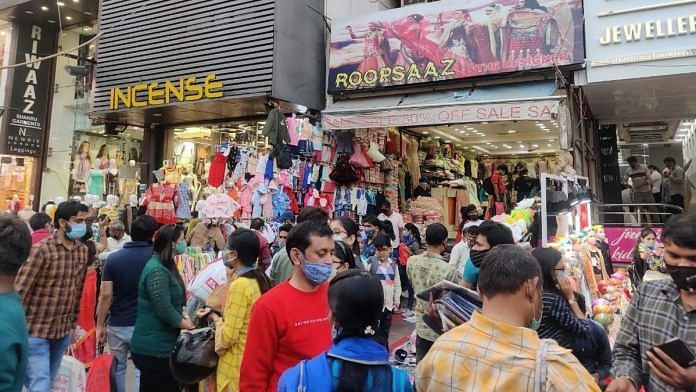New Delhi: Covid-19 cases in the national capital surged to 6,842 cases Wednesday, making it the highest single-day number to rock the city. But this didn’t come as a surprise, say experts, who attribute the rise in cases to the festive season, rise in pollution, lax contact-tracing measures, and stark drop in temperatures.
Chief Minister Arvind Kejriwal said Wednesday the city was experiencing a “third wave” of infections after cases hovered between 3,000 and 5,000 in September and October.
The city’s positivity rate has shot up to 11.29 per cent, and its cumulative case count has crossed 4 lakh.
On Thursday, Delhi reported 6,715 cases even as the country saw 47,682 cases overall. This means the cases in the capital city amounted to around 14 per cent of the total load in the day.
This surge appears stark in comparison to other high-burden states like Maharashtra and Karnataka, where Covid cases have stayed at the same level over the past week or so. On the whole, India’s daily caseload has been declining since mid-September.
“Cases are rising (in Delhi) due to overcrowding in markets in the festive season. People are going shopping but not wearing masks. Even if they are wearing masks, they are not wearing it properly,” Dr B.L. Sherwal, director of Rajiv Gandhi Super Specialty Hospital, told ThePrint.
“In addition, temperatures are also dipping and pollution is rising. All this has contributed to a spike in cases,” said Sherwal.
Also read: Good news from India’s Covid battle — fatality rate is down 50% since May
Factors aligning for Covid surge
The India Meteorological Department could declare a cold wave in the city after temperatures dropped to 10 degrees Celsius Tuesday — a factor that many public health experts say could play a role in the rise in cases.
“We haven’t had a uniform epidemic in India, so this rise in cases is a ripple effect of the epidemic’s ebbs and flows. It’s difficult to point to any factor and say it is the cause for cases, but there has been a marked drop in temperature and change in human behaviour, both of which are contributing factors,” said Dr Preeti Kumar, vice president, health support systems, Public Health Foundation of India.
Pollution too worsened to the “severe” category after the city’s AQI reading soared to 452 Thursday.
“When temperatures drop, we generally see a rise in respiratory infections, especially since pollution has also been rising,” said Dr Jugal Kishore, head of community medicine at Safdarjung Hospital.
Quarantine fatigue and Diwali preparations are causing people to go outside without hesitation, he added. “People are tired and don’t want to miss out on the festival. They’re exhausted of the fear and are willing to take the risk.”
Also read: Modi govt panel rejects emergency-use approval for Dr Reddy’s potential Covid drug
Testing and surge trend
Anant Bhan, researcher in global health and bioethics, said, “Contrary to the perception that (in) many parts of urban India, infection has already spread and numbers are coming down now, Delhi shows that people are still susceptible. So this takes us back to the old adage that prevention and control of infection are the only two ways to go about it.”
Bhan added that Delhi’s high numbers could be because, in comparison to other states, it relies more heavily on the gold-standard RT-PCR.
“Several states on the other hand are relying more on antigen testing so their numbers may appear less due to risk of false negatives,” he said.
Dr Sanjiv Kumar, chairman of the Indian Academy of Public Health, said even though Delhi has increased its testing, the high positivity rate shows there are many more undetected infections.
“For a city with only 1.5 per cent of the country’s population, it accounted for 14 per cent of cases on 5 November. This shows there is some laxity in early testing and contact tracing to catch the virus early. The pool of infection lies in active cases, and even though we are testing a lot of people, there are likely many more cases which haven’t been detected but spreading infection, causing a surge,” he said.
“Rigorous contact tracing is the only way to pick up the virus early,” added Kumar.
In his statements, CM Kejriwal has assured that there are enough beds for Covid patients in the national capital.
“What we need to look out for is hospitalisation patterns that emerge in the next 15-21 days. We will need to study which cohorts are getting infected and their outcomes,” Preeti added.
Also read: Final results of US trial reveal remdesivir could shorten recovery time in Covid patients



